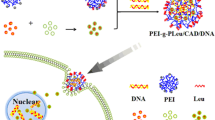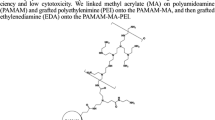Abstract
Purpose
Dynamic PEG-polycation copolymers that release PEG and degrade into small fragments after cell entry might present efficient and biocompatible gene carriers.
Methods
PEG-OEI-MK was synthesized by copolymerization of 5 kDa polyethyleneglycol (PEG) and 800 Da oligoethylenimines through acid-degradable acetone-bis-(N-maleimidoethyl)ketal linkers (MK). To evaluate any benefit of the reversible over stable linkage, also the corresponding pH-stable analog, PEG-OEI-BM, was synthesized via ether linkages. Luciferase and GFP expression plasmids were used for transfections, in vivo biocompatibility was evaluated by intravenous application of polymers in Balb/c mice.
Results
PEG-OEI-MK showed efficient DNA binding as analyzed by ethidium bromide exclusion, resulting in formation of polyplexes with sizes around 100 nm and surface charges of below 5 mV zeta potential. This surface shielding of PEG-OEI-MK polyplexes remained stable at neutral pH 7.4, while polyplexes deshielded and aggregated at pH 5 within 15–30 min. Cell culture experiments demonstrated reduced polymer toxicity compared to the non-PEGylated OEI-MK. Transfection experiments demonstrated reduced gene expression of PEG-OEI-BM compared with the non-PEGylated analog OEI-BM, whereas the pH-reversible polymer PEG-OEI-MK mediated a significant increased transfection efficiency over the non-PEGylated OEI-MK.
Conclusions
PEG-OEI-MK mediated the highest gene transfer at lowest cytotoxicity levels and also best in vivo biocompatibility.








Similar content being viewed by others
Abbreviations
- AP:
-
alkaline phosphatase
- AST:
-
aspartate aminotransferase
- BM:
-
1,8-bis-maleimidodiethyleneglycol
- DCM:
-
dichloro methane
- EtBr:
-
ethidium bromide
- FCS:
-
fetal calf serum
- HBG:
-
Hepes buffered glucose (5% (w/v) glucose, 20 mM Hepes, pH 7.4)
- 0.5× HBS:
-
Hepes buffered salt (2.5% glucose (w/v), 75 mM NaCl, 20 mM Hepes, pH 7.4)
- Hepes:
-
N-2-hydroxyethylpiperazine-N′-2-ethane sulfonic acid
- MFI:
-
mean fluorescence intensity
- MK:
-
2,2-bis(N-maleimidoethyloxy) propane
- m.w.:
-
molecular weight
- Mw:
-
molecular weight by weight
- NaOAc:
-
sodium acetate
- OEI800:
-
oligoethylenimine with an average molecular weight of 800 Da
- PEG5K-SH:
-
methoxy poly(ethylene glycol) thiol, average molecular weight 5 kDa
- PEI25K:
-
branched polyethylenimine with an average molecular weight of 25 kDa
- PEI22K:
-
linear polyethylenimine with an average molecular weight of 22 kDa
- RLU:
-
relative light units
- s.d.:
-
standard deviation
- U/l (37°C):
-
units per liter plasma, measured at 37°C
References
J. Wang, H. Q. Mao, and K. W. Leong. A novel biodegradable gene carrier based on polyphosphoester. J. Am. Chem. Soc. 123:9480–9481 (2001). doi:10.1021/ja016062m.
Y. B. Lim, S. M. Kim, H. Suh, and J. S. Park. Biodegradable, endosome disruptive, and cationic network-type polymer as a highly efficient and nontoxic gene delivery carrier. Bioconjug. Chem. 13:952–957 (2002). doi:10.1021/bc025541n.
M. L. Forrest, J. T. Koerber, and D. W. Pack. A degradable polyethylenimine derivative with low toxicity for highly efficient gene delivery. Bioconjug. Chem. 14:934–940 (2003). doi:10.1021/bc034014g.
D. G. Anderson, D. M. Lynn, and R. Langer. Semi-automated synthesis and screening of a large library of degradable cationic polymers for gene delivery. Angew. Chem. Int. Ed. Engl. 42:3153–3158 (2003). doi:10.1002/anie.200351244.
J. J. Green, J. Shi, E. Chiu, E. S. Leshchiner, R. Langer, and D. G. Anderson. Biodegradable polymeric vectors for gene delivery to human endothelial cells. Bioconjug. Chem. 17:1162–1169 (2006). doi:10.1021/bc0600968.
J. Kloeckner, E. Wagner, and M. Ogris. Degradable gene carriers based on oligomerized polyamines. Eur. J. Pharm. Sci. 29:414–425 (2006). doi:10.1016/j.ejps.2006.08.002.
M. Thomas, J. J. Lu, C. Zhang, J. Chen, and A. M. Klibanov. Identification of novel superior polycationic vectors for gene delivery by high-throughput synthesis and screening of a combinatorial library. Pharm. Res. 24:1564–1571 (2007). doi:10.1007/s11095-007-9279-3.
L. V. Christensen, C. W. Chang, W. J. Kim, S. W. Kim, Z. Zhong, C. Lin, J. F. Engbersen, and J. Feijen. Reducible poly(amido ethylenimine)s designed for triggered intracellular gene delivery. Bioconjug. Chem. 17:1233–1240 (2006). doi:10.1021/bc0602026.
D. S. Manickam, and D. Oupicky. Multiblock reducible copolypeptides containing histidine-rich and nuclear localization sequences for gene delivery. Bioconjug. Chem. 17:1395–1403 (2006). doi:10.1021/bc060104k.
Y. Lee, H. Mo, H. Koo, J. Y. Park, M. Y. Cho, G. W. Jin, and J. S. Park. Visualization of the degradation of a disulfide polymer, linear poly(ethylenimine sulfide), for gene delivery. Bioconjug. Chem. 18:13–18 (2007). doi:10.1021/bc060113t.
J. J. Hoon, L. V. Christensen, J. W. Yockman, Z. Zhong, J. F. Engbersen, K. W. Jong, J. Feijen, and K. S. Wan. Reducible poly(amido ethylenimine) directed to enhance RNA interference. Biomaterials. 28:1912–1917 (2007). doi:10.1016/j.biomaterials.2006.12.019.
C. Lin, C. J. Blaauboer, M. M. Timoneda, M. C. Lok, M. van Steenbergen, W. E. Hennink, Z. Zhong, J. Feijen, and J. F. Engbersen. Bioreducible poly(amido amine)s with oligoamine side chains: synthesis, characterization, and structural effects on gene delivery. J. Control. Release. 126:166–174 (2008). doi:10.1016/j.jconrel.2007.11.012.
J. Kloeckner, S. Bruzzano, M. Ogris, and E. Wagner. Gene carriers based on hexanediol diacrylate linked oligoethylenimine: effect of chemical structure of polymer on biological properties. Bioconjug. Chem. 17:1339–1345 (2006). doi:10.1021/bc060133v.
V. Russ, H. Elfberg, C. Thoma, J. Kloeckner, M. Ogris, and E. Wagner. Novel degradable oligoethylenimine acrylate ester-based pseudodendrimers for in vitro and in vivo gene transfer. Gene Ther. 15:18–29 (2008). doi:10.1038/sj.gt.3303046.
S. Y. Wong, J. M. Pelet, and D. Putnam. Polymer systems for gene delivery—past, present, future. Prog. Polym. Sci. 32:799–837 (2007). doi:10.1016/j.progpolymsci.2007.05.007.
V. Knorr, V. Russ, L. Allmendinger, M. Ogris, and E. Wagner. Acetal linked oligoethylenimines for use as pH-sensitive gene carriers. Bioconjug. Chem. 19:1625–1634 (2008). doi:10.1021/bc8001858.
C. Plank, K. Mechtler, F. C. Szoka Jr., and E. Wagner. Activation of the complement system by synthetic DNA complexes: a potential barrier for intravenous gene delivery. Hum. Gene Ther. 7:1437–1446 (1996). doi:10.1089/hum.1996.7.12-1437.
P. Chollet, M. C. Favrot, A. Hurbin, and J. L. Coll. Side-effects of a systemic injection of linear polyethylenimine-DNA complexes. J. Gene Med. 4:84–91 (2002). doi:10.1002/jgm.237.
M. Ogris, S. Brunner, S. Schuller, R. Kircheis, and E. Wagner. PEGylated DNA/transferrin-PEI complexes: reduced interaction with blood components, extended circulation in blood and potential for systemic gene delivery. Gene Ther. 6:595–605 (1999). doi:10.1038/sj.gt.3300900.
P. Erbacher, T. Bettinger, P. Belguise-Valladier, S. Zou, J. L. Coll, J. P. Behr, and J. S. Remy. Transfection and physical properties of various saccharide, poly(ethylene glycol), and antibody-derivatized polyethylenimines (PEI). J. Gene Med. 1:210–222 (1999). doi:10.1002/(SICI)1521-2254(199905/06)1:3<210::AID-JGM30>3.0.CO;2-U.
D. Oupicky, M. Ogris, K. A. Howard, P. R. Dash, K. Ulbrich, and L. W. Seymour. Importance of lateral and steric stabilization of polyelectrolyte gene delivery vectors for extended systemic circulation. Mol. Ther. 5:463–472 (2002). doi:10.1006/mthe.2002.0568.
M. Mannisto, S. Vanderkerken, V. Toncheva, M. Elomaa, M. Ruponen, E. Schacht, and A. Urtti. Structure-activity relationships of poly(L-lysines): effects of pegylation and molecular shape on physicochemical and biological properties in gene delivery. J. Control. Release. 83:169–182 (2002). doi:10.1016/S0168-3659(02)00178-5.
W. Li, Z. Huang, J. A. MacKay, S. Grube, and F. C. Szoka Jr. Low-pH-sensitive poly(ethylene glycol) (PEG)-stabilized plasmid nanolipoparticles: effects of PEG chain length, lipid composition and assembly conditions on gene delivery. J. Gene Med. 7:67–79 (2005). doi:10.1002/jgm.634.
M. Oishi, Y. Nagasaki, K. Itaka, N. Nishiyama, and K. Kataoka. Lactosylated poly(ethylene glycol)-siRNA conjugate through acid-labile beta-thiopropionate linkage to construct pH-sensitive polyion complex micelles achieving enhanced gene silencing in hepatoma cells. J. Am. Chem. Soc. 127:1624–1625 (2005). doi:10.1021/ja044941d.
G. F. Walker, C. Fella, J. Pelisek, J. Fahrmeir, S. Boeckle, M. Ogris, and E. Wagner. Toward synthetic viruses: endosomal pH-triggered deshielding of targeted polyplexes greatly enhances gene transfer in vitro and in vivo. Mol. Ther. 11:418–425 (2005). doi:10.1016/j.ymthe.2004.11.006.
A. A. Kale, and V. P. Torchilin. “Smart” drug carriers: PEGylated TATp-modified pH-sensitive liposomes. J. Liposome Res. 17:197–203 (2007). doi:10.1080/08982100701525035.
V. Knorr, L. Allmendinger, G. F. Walker, F. F. Paintner, and E. Wagner. An acetal-based PEGylation reagent for pH-sensitive shielding of DNA polyplexes. Bioconjug. Chem. 18:1218–1225 (2007). doi:10.1021/bc060327a.
D. B. Rozema, D. L. Lewis, D. H. Wakefield, S. C. Wong, J. J. Klein, P. L. Roesch, S. L. Bertin, T. W. Reppen, Q. Chu, A. V. Blokhin, J. E. Hagstrom, and J. A. Wolff. Dynamic PolyConjugates for targeted in vivo delivery of siRNA to hepatocytes. Proc. Natl. Acad. Sci U. S. A. 104:12982–12987 (2007). doi:10.1073/pnas.0703778104.
C. Fella, G. F. Walker, M. Ogris, and E. Wagner. Amine-reactive pyridylhydrazone-based PEG reagents for pH-reversible PEI polyplex shielding. Eur. J. Pharm. Sci. 34:309–320 (2008). doi:10.1016/j.ejps.2008.05.004.
H. Hatakeyama, H. Akita, K. Kogure, M. Oishi, Y. Nagasaki, Y. Kihira, M. Ueno, H. Kobayashi, H. Kikuchi, and H. Harashima. Development of a novel systemic gene delivery system for cancer therapy with a tumor-specific cleavable PEG-lipid. Gene Ther. 14:68–77 (2007). doi:10.1038/sj.gt.3302843.
M. Meyer, and E. Wagner. pH-responsive shielding of non-viral gene vectors. Expert. Opin. Drug Deliv. 3:563–571 (2006). doi:10.1517/17425247.3.5.563.
B. Brissault, A. Kichler, C. Guis, C. Leborgne, O. Danos, and H. Cheradame. Synthesis of linear polyethylenimine derivatives for DNA transfection. Bioconjug. Chem. 14:581–587 (2003). doi:10.1021/bc0200529.
C. Plank, K. Zatloukal, M. Cotten, K. Mechtler, and E. Wagner. Gene transfer into hepatocytes using asialoglycoprotein receptor mediated endocytosis of DNA complexed with an artificial tetra-antennary galactose ligand. Bioconjug. Chem. 3:533–539 (1992). doi:10.1021/bc00018a012.
F. Ungaro, G. De Rosa, A. Miro, and F. Quaglia. Spectrophotometric determination of polyethylenimine in the presence of an oligonucleotide for the characterization of controlled release formulations. J. Pharm. Biomed. Anal. 31:143–149 (2003). doi:10.1016/S0731-7085(02)00571-X.
R. Kircheis, A. Kichler, G. Wallner, M. Kursa, M. Ogris, T. Felzmann, M. Buchberger, and E. Wagner. Coupling of cell-binding ligands to polyethylenimine for targeted gene delivery. Gene Ther. 4:409–418 (1997). doi:10.1038/sj.gt.3300418.
S. Boeckle, K. von Gersdorff, S. van der Piepen, C. Culmsee, E. Wagner, and M. Ogris. Purification of polyethylenimine polyplexes highlights the role of free polycations in gene transfer. J. Gene Med. 6:1102–1111 (2004). doi:10.1002/jgm.598.
K. von Gersdorff, M. Ogris, and E. Wagner. Cryoconserved shielded and EGF receptor targeted DNA polyplexes: cellular mechanisms. Eur. J. Pharm. Biopharm. 60:279–285 (2005). doi:10.1016/j.ejpb.2004.08.014.
S. Han, R. I. Mahato, Y. K. Sung, and S. W. Kim. Development of biomaterials for gene therapy. Mol. Ther. 2:302–317 (2000). doi:10.1006/mthe.2000.0142.
D. W. Pack, A. S. Hoffman, S. Pun, and P. S. Stayton. Design and development of polymers for gene delivery. Nat. Rev. Drug Discov. 4:581–593 (2005). doi:10.1038/nrd1775.
E. Wagner, and J. Kloeckner. Gene delivery using polymer therapeutics. Adv. Polym. Sci. 192:135–173 (2006). doi:10.1007/12_023.
D. Schaffert, and E. Wagner. Gene therapy progress and prospects: synthetic polymer-based systems. Gene Ther. 15:1131–1138 (2008). doi:10.1038/gt.2008.105.
E. Wagner. Programmed drug delivery: nanosystems for tumor targeting. Expert. Opin. Biol. Ther. 7:587–593 (2007). doi:10.1517/14712598.7.5.587.
J. A. Wolff, and D. B. Rozema. Breaking the Bonds: Non-viral Vectors Become Chemically Dynamic. Mol. Ther. 16:8–15 (2008). doi:10.1038/sj.mt.6300326.
Acknowledgments
We thank Olga Brück for skillful assistance in preparing the manuscript, as well as Wolfgang Roedl and Anna Kulinyak for competent technical assistance. This work was funded by the LMU university, by the DFG projects SFB 486 ‘Nanoman’ and SPP1230, the Nanosystems Initiative Munich (NIM), and the European Community FP6 network project ‘GIANT’.
Author information
Authors and Affiliations
Corresponding author
Rights and permissions
About this article
Cite this article
Knorr, V., Ogris, M. & Wagner, E. An Acid Sensitive Ketal-Based Polyethylene Glycol-Oligoethylenimine Copolymer Mediates Improved Transfection Efficiency at Reduced Toxicity. Pharm Res 25, 2937–2945 (2008). https://doi.org/10.1007/s11095-008-9700-6
Received:
Accepted:
Published:
Issue Date:
DOI: https://doi.org/10.1007/s11095-008-9700-6




